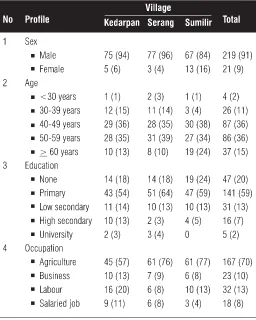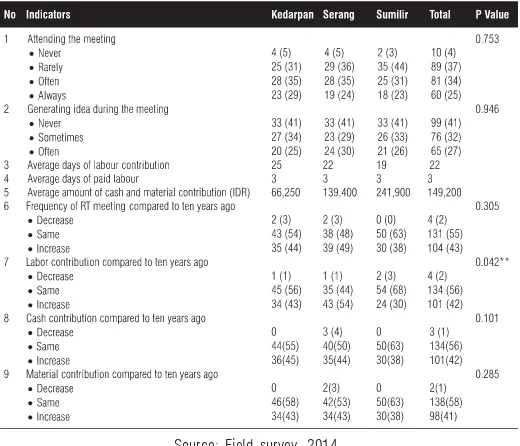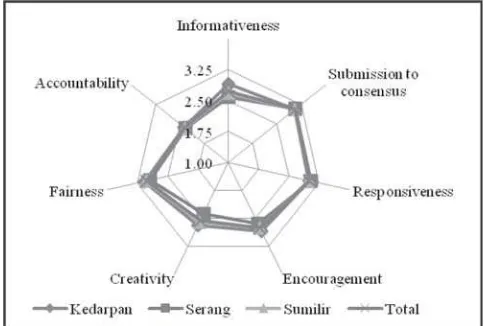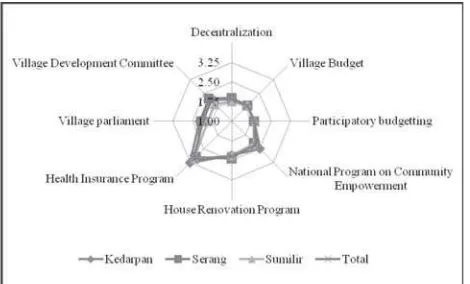performing the roles that still cannot be played by RT.
KEYWORDS: Neighborhood Group, Participatory Development, Decen-tralization
INTRODUCTION
After the collapse of Suharto regime, Indonesia rapidly moved from centralized to decentralized country. In 2001, the government transferred power, tasks and budget for rural development to village government. This moment made a fundamental shift in rural development, from top-down to bottom-up approach. It aimed to facilitate
communityparticipation, improve local capacity and em-power community.
While decentralization increased the power of village government, rural institutions could not be regarded as dynamic part of decentralization. Despite the introduction of village parliament, most of the otherinstitutions were not changed much in term of structure and pattern of relationship(Sutiyo & Maharjan, 2014).Thus, there are many concerns on whether decentralization could be effectively implemented throughthis rural institution setting.
In the initial years of decentralization, several studies find that there had been some positive changes toward more participatory rural development in Indonesia.Alatas, Pritchett, and Wetterberg (2005) find that decentralization improved community membership in rural institutions, especially in groups providing services of health, education, finance and general neighborhood assistance. Another
in Indonesia: Case of Three Villages
in Purbalingga District, Central
Java Province
http://dx.doi.org/10.18196/jgp.2015.0010
ABSTRACT
study conducted by Antlöv (2003) also finds that decentralization improved community participa-tion in rural development, especially by providing space for dialogue in development planing and establishing a mechanism of accountability.
Antlöv (2003), Alatas et al. (2005)and many other studies have presented that the policy of decentralization launched in 2001 has been a starting point in creating a more participatory and democratic local government. However, no one can guarantee that decentralization will be success-ful in achieving its objectives. To be successsuccess-ful, decentralization always needs an active government and civil society engagement that will ensure that the regulations are not distorted during implemen-tation and that communities are continuously involved in development processes (Antlöv, 2003).
Currently, after about fourteen years of decen-tralization, little is known about the implementa-tion of decentralizaimplementa-tion in grassroots level. Whether positive changes in the initial years of decentralization are still continued and institution-alized in village governance is still a big question. In-depth analysis of interaction between commu-nity, institution and government is therefore needed to understand what really happening. While the other studies analyze village governance as a unity of many kinds of rural institutions, this study tries to focus on one institution, namely Neighborhood Groups (Rukun Tetangga/RT). Whether this institution could promote participa-tory rural development is the central question in this study.
Analyzing roles of an institution in participatory development requires attention to specific pro-cesses, which include the ways in which community is involved in rural development, the leadership
capacity of institution heads, and the impact of those processes on community
empowerment.Thus, the rest of this paper is organized as follows: Section 2 will provide litera-ture reviews; Section 3 will present research method and data set; Section 4 will present find-ings consisting of description of research location, community participation, leadership capacity and community empowerment within RT; Section 5 will develop discussion; Section 6 will draw conclu-sion and policy implication.
THEORITICAL FRAMEWORK
Neighborhood Group (RukunTetangga/RT)is an association of fifty to hundred households living in the same area. The head is elected by community, and all households are automatically the member. In the structure of village government, RT pro-vides a connecting line between village govern-ment and households.
Although the war was ended in 1945, the structure of RT continued to exist. Even, through Regulation of Ministry of Home Affairs 7/19831,
the government of Indonesia made it a mandatory organization throughout Indonesian areas. Virtu-ally established in all areas of Indonesia, RT then became one of the most effective state initiated groups reaching community.
It should be noted that the position of RT is ambiguous.The regulation stipulates that it is a community organization to provide neighborhood assistance to villagers. Yet, RT was also given bulky governmental tasks and became the lowest state institutions reaching households. Thus, RT plays dual roles, either as a community organization or as a pseudo governmental institution. As commu-nity organization, RT manages daily affairs of community, which include collecting garbage, promoting peace, conducting night patrol, holding marriage, funerals and religius ceremonies, clean-ing roads and other infrastructures (Dwianto, 2003; Grootaert, 1999). As a pseudo administrative institution, it has tasks to collect property taxes and dues, update demographic data, socialize govern-ment programs andconnect the communication between villagers and village government(Antlöv, 2000).
During Suharto administration, although it was propagandized that public participation was encour-aged in rural development, numerous studies present that what really happening was a bureau-cratization of village government.Study by Antlöv (1995) in one village of West Java province finds that given the nature of authoritarian regime at that time, virtually all rural institutions, including RT, were made as client of the state. Power was monopolized by village elites focusing on relations
with central power holders at the expense of community. Participatory processes in RT were just a formality, and RT heads just became a tool of the state to collect taxes and to mobilize cash and labour contributions. Similarly, another study conducted by Warren (1990) in several villages in Bali province also finds that rural institutions, including RT, played passive roles in rural develop-ment due to intervention from governdevelop-ment agencies.
Whilemany studies find that RT plays only passive roles in executing participatory develop-ment during Suharto administration, several studies find that RT can help villagers in addressing their livelihood problems. For example, study by Grootaert (1999) in 48 villages of six districts finds that community perceived RT as one of the most important rural institutions to help their livelihood problems. Most RTs had monthly meeting to discuss local issues like road maintenance, infra-structure reparation, religius ceremoniesand local festive. In the same location, Evers (2000)finds that with regard to participatory development, commu-nity initiatives and collective actions were focused within RT. This was because community had no formal instrument to influence village govern-ment, and trust between villagers and their formal leaders was low.
After decentralization was launched, the govern-ment perceived RT as one of potential organiza-tions to execute decentralization in village level. Several regulations clearly mention that RT should be involved in the whole of rural development processes2. Various tasks were mandated to RT, like
sharing village government accountability report, and more importantly, empowering community and increasing their democratic skill.
Either study by Grootaert (1999), Evers (2000), Antlöv (2003)or Sutiyo and Maharjan (2014) present the importance of RT in promoting participatory development within decentralization context. As the lowest administration level, RT is deemed to have strong roots within community and can organize villagers better than the other institutions. Just like the other rural institutions, the effectiveness of RT in promoting participatory development will hypothetically depend on govern-ment commitgovern-ment to support and always involve this institution in the whole development process (Antlöv, 2003), and whether RT itself can manage internal conflicts, eliminate domination of certain people and continuously improve its capacity though learning process (Uphoff & Buck, 2006).
RESEARCH METHODS
This study is a kind of case study at village level. Three villages were purposively selected to be the study sites, namely Kedarpan, Serang and Sumilir villages in Purbalingga District, Central Java Province. Data were collected by interviews, ques-tionnaires, observations and documentary study, during June to July 2014. This study purposively selected 8 RTs in each village, and 10 households from each RT were randomly selected. Total respondents were 240 households.
Data were collected through observation, interview and questionnaires, and are analyzed through both qualitative and quantitative tech-niques. Test of questionnaire validity was con-ducted through item analysis by using Pearson Product-Moment correlation, and reliability test
was conducted through Cronbach Alpha test. Only the questions that pass the tests are utilized in the subsequent calculation. Respondent’s perception is arranged in Likert scale ranging from poor (score 1), slightly poor (score 2), good enough (score 3) and good (score 4). Further, respondent’s answer is summed, and a mean is created by dividing total score by total respondents. The interpretation of the mean is: Score 1-1.74: poor; Score 1.75-2.49: slightly poor; Score 2.5-3.24: good enough; Score 3.25-4: good.
To measure the capacity of RT heads, this study uses indicators of community leadership capacity developed by Sutiyo and Maharjan (2014). The indicators were derived from combination of leader-ship concept and traditional roles of leader in Javanese society. The indicators include informative-ness, encouragement, accountability, fairinformative-ness, cre-ativity, responsiveness and submission to consensus.
With regard to community empowerment, this study emphasizes empowerment as a process to improve villager’s skill to participate in the decen-tralization context. Community skills in decentraliza-tion are measured through several proxies, which are the understanding on terms of decentralization, understanding on some major government pro-grams implemented in the study sites, and under-standing on some village institutions.
RESULT AND ANALYSIS
DESCRIPTION OF STUDY VILLAGES AND
RE-SPONDENTS
The villages of Kedarpan, Serang and Sumilir covered an area of 13.09 km2, 2.25 km2 and 2.26
km2, respectively. Number of RTs was 11 groups in
in Kedarpan, 1,256 households living in Serang, and 564 households living in Sumilir.
Among 240 respondents selected by this study, majorityof them were male (91%), aged between 40 and 49 years (36%) and graduated from primary level (59%). Most respondents worked in agricul-ture (59%), with landholding mostly less than 0.5 ha (Table 1).
COMMUNITY PARTICIPATION IN RT
Having tasks to promote participatory develop-ment, it was important for RT to have a periodic meeting with the member. It was found that17 RTs had periodic meeting, mostly monthly. Further, in 2 RTs in Serang and 3 RTs in Sumilir, the meeting
was not held periodically but as per need. In
Kedarpan, 2 RTs never arranged meeting for years. However, real participation is not simply carry-ing meetcarry-ings, but also attendance and quality of discussion. With regard to community attendance in RT meeting, it was found that most respondents (59%) often or always came to attend the meeting (Table 2). This means that community attendance was quite good. However, most respondents never generated idea during the meeting. Thus, the meeting basically had no dynamic discussion.Most respondents had limited involvement in decision making, and came to the meeting just to listen the information delivered by RT heads and village apparatus.
TABLE 1: SOCIO ECONOMIC CONDITION OF RESPONDENTS
Source: Field survey, 2014.
It should be noted that for most villagers, the meeting in RT was the only meeting that they could join.Meeting at village level usually only invited the heads of RT, village parliament and some other rural institutions. Decree of
Purbalingga District Head 14/20103, which was the
main technical regulations related to village devel-opment planning, stipulated that it was procedur-ally enough to conduct village planning meeting just by involving village apparatus, head of village parliament (BPD), head of village development committee (LKMD), heads of RTs and some community prominent figures.
Although community came to the meeting just as listener and was not deeply involved in decision making, resources mobilization was surprisingly high. Coercive methods from RT heads were not found. This means that community voluntarily contributed to projects. Social pressure, in which a villager was fearful of being criticized by neighbors if he did not contribute, was part of the motivating
factor why resource mobilization was high. Days of labour contribution in government project and self-initiated infrastructure mainte-nance were averagely 22 days per year, with no significant difference across the study villages (Table 2). Most activities had been routinely sched-uled, for example once a month to maintain the road, once in six month to maintain irrigation channel, once a year to maintain cemetery, public well and mosque. Cash and material contribution was averagely IDR 149,183 a year, with the highest rate in Sumilir. This amount was equivalent to the wage of 4 days-labour in cropland.
Most respondent perceived that frequency of RT meeting and labour and cash contribution were the same as ten years before. However, substantial number of respondents perceived that the indica-tors were increased. This means that the change to be more participatory community organization was happening in RT.
TABLE 2: COMMUNITY PARTICIPATION IN RT
Source: Field survey, 2014.
3. CAPACITY OF RT HEADS
To understand the capacity of RT heads, it was important to consider that becoming RT heads was a voluntary job receiving no incentives. Some villagers were appointed to becomeRT headsimply because no one was willing to hold this job. Most RT heads had education in primary level and occupation as farmer.
It was found that informativeness, submission to consensus, responsiveness, encouragement, creativ-ity and fairness were good enough. Yet, account-ability was slightly poor (Figure 1).
FIG. 1: RESPONDENT’S PERCEPTION ON CAPACITY OF RT HEAD Source: Field survey, 2014
Note: Score 1-1.74: poor; 1.75-2.49: slightly poor; 2.5-3.24: good enough; 3.25-4: good
Most respondentsperceived that RT heads were informative enough, in which they informed and socialized government programs to the villagers in RT meeting. Any decisions made during the meeting weremostly followed by the RT head, thus most respondents perceived that the indicator of submission to consensus was good enough.
RT was the closest institution with community, thus it confronted day-to-day community problems, complaints and other affairs. Most respondents perceived that RT heads were responsive enough
to those problems. During project implementa-tion, they motivated and encouraged villagers to voluntarily contribute labor. However, many respondents perceived that their creativity was a little bit low. The way to solve problems was with-out innovation. This is why the score of creativity was slightly low. Relatively low score of creativity might be related to the education of RT heads which was mostly primary level. Further, most respondents perceived that RT heads were fair enough, in which theytreated everyvillager without discrimination.
With regard to accountability, many respon-dents perceived that they were rarely given report of village budget.Many said that information about development projects were given just before the projects was started, especially related to the name of programs and what villagers should do in the implementation. However, after the projects were finished, very limited information about budget utilization was shared to community.
There was indication that their low score in accountability was a result of the same low-account-ability from the higher administrative level. Village responsibility meeting, which was supposed to be a meeting where village head reported the fund utilization, was not always conducted. Many RT heads said that they were given neither informa-tion of village budget nor other project from village head, thus nothing could they share to the community. Report of fund utilization was only printed for the district government.
COMMUNITY EMPOWERMENT THROUGH RT
under-standing on terms of decentralization
(OtonomiDaerah), which was broadly quoted in Indonesia, and participatory budgeting
(Musrenbang), which was annually held, was slightly low. Most respondents just ever heard the terms, but did not understand the meaning (Figure 2).
FIG. 2: RESPONDENT’S UNDERSTANDING ON DECENTRALIZATION MATTERS Source: Field survey, 2014
Note: Score 1-1.74: poor; 1.75-2.49: slightly poor; 2.5-3.24: good enough; 3.25-4: good
The understanding on some major develop-ment programs, like National Program for Com-munity Empowerment (Program Nasional
Pemberdayaan Masyarakat) and House Renovation Program (Program Pemugaran Rumah Miskin), Village Budget (Alokasi Dana Desa) were slightly low. Whereas, the three programs were imple-mented in their village annually. Most respondents just ever heard the program, but did not know the meaning, program recipients, amount of fund and its utilization. Further, understanding on Health Insurance Program (Askeskin) was good enough because many respondents became the recipients (Figure 2).
The understanding on matters related to village government, like Village Parliament (Badan
Permusyawaratan Desa/BPD) and Village Develop-ment Committee (Lembaga Ketahanan Masyarakat Desa/LKMD) were low. Most respondent did not know the members of these institutions and their tasks (Figure 2).
Low community understanding on decentraliza-tion indicates that the process ofdeveloping com-munity capacity through RT was not completely successful. In the other words, community empow-erment was not effectively channelized through RT.Some trainings were conducted by district government, but only for village head and appara-tus. Although some capacity existed in RT heads, it was not a result of capacity development from district government but a learning by doing pro-cess.
Related to participation in RT, it can be said the quality of community involvement is pseudo participation emphasizing more on resource mobilization but less in decision making. Although periodicmeeting exists in most RTs, the essence of participation is not real.
Community perceived leadership capacity of RT heads as good enough, mostly with high scores in indicators related to traditional leaders and low scores to indicators related to accountability and creativity. Although it is still far from being clear, this phenomenon indicates that RT heads are not able to transform themselves to practice the principle of modern organization.
community may be not aware about the change happening in the decentralization system.
Findings of this study are contrary to Grootaert (1999) and Evers (2000). While they find that RT, as community organization, could manage com-mon livelihoods problems of community, this study finds that as pseudo administrative units, RTis not completely successful. This institution is not able to facilitate broad participation, accountability and capacity development for community, or to be the institution where villagers learn democratic skills in decentralization.
However, this does not happen only on the community as the target of empowerment, but also in the RT heads as the community leaders. As findings of this study presents, indicators in term of creativity and accountability were low. This means that capacity development to them was also
low.Thus, what really happening is that the role of RT may depend on the capacity development to its head.
Yet, some potentialities are identified. For example, most RTs hold scheduled meetings, and substantial number of respondent perceived that participation is increased in the last ten years. Further, in most indicators of leadership capacity, RT heads have performed their role as a good enough community leader. Thus, what the govern-ment should do is to optimize the potentialities of RT.
Looking at the current conditions of RT, there are two options can be done for improving the success of decentralization. The first is to develop the capacity of RT head, so that they can practice accountability, improve creativity and transfer their knowledge on decentralization to community. As far as capacity development was delivered to them,
and accountability is shared to them, it will be very probably that they will share to community.
The second, hand in hand with capacity devel-opment to RT heads, the government should not limit the bottom-up proposal and participatory development only through RT. The other institu-tions in rural areas should be involved to help playing the roles that cannot be played by RT.
CONCLUSION AND RECOMMENDATION
It can be generally concluded that RT is not completely successful in promoting participatory rural development. Community participation does not substantively happen in RT, and there are leadership problems implying to the weak institu-tional capacity of RT. As an impact, community empowerment is not optimally channelized
through RT. As this study presents, complexities of institutional problems, which range from weak capacity, trouble in technical regulation and lack of support from government, are among the factors hampering RT to perform its roles. What happen-ing in RT indicates that the participatory develop-ment is still far from being institutionalized in Indonesian decentralization.
to help playing the roles cannot be played by RT. Theoretically, this study also suggests that preparing the technical regulations, improving the capacity of local institutions and restructuring rural institutional setting should be an important step before decentralization is launched. To be success-ful in promoting participatory rural development, decentralization requires strong commitment and continuous support from the government to overcome the problems of implementation at grassroots level.
ACKNOWLEDGEMENT
The author would like to thank to the Sumitomo Foundation of Japan, which provides research grant for this study through the program of Grant for Japan-Related Research Project, 2013.
ENDNOTES
1 Permendagri 7/1983 tentang Pembentukan RT dan RW
2 Government Regulation 72/2005 on Village; Presidential Regulation 49/2001 on Guideline of Rural Community Institution; Regulation of Ministry of Home Affairs 5/2007 on Guideline of Rural Community Institution Arrangement 3 Peraturan Bupati Purbalingga No. 14 tahun
2010 tentang Pedoman Alokasi Dana Desa
REFERENCES
Alatas, V., Pritchett, L., & Wetterberg, A. (2005).
Voice Lessons: Local Government Organizations, Social Organizations and the Quality of Local Governance. Jakarta: The World Bank Indonesia. Antlöv, H. (1995). Exemplary Center, Administrative
Periphery. Rural Leadership and the New Order in Java. London: Curzon Press.. London: Curzon
Press.
Antlöv, H. (2000). Village Governance in Indonesia: Past, Present and Future Challenges. Paper pre-sented at the Conference on Dynamic of Local Politic in Indonesia, Yogyakarta.
Antlöv, H. (2003). Village Government and Rural Development in Indonesia: The New Demo-cratic Framework. Bulletin of Indonesian Economic Studies, 39(2), 193-214.
Dwianto, R. D. (2003). The Existing Form of Urban Locality Groups in Jakarta: Reexamining the RT/RW in the post-New Order Era. In T. Mizuuchi (Ed.), Representing Local Places and Rising Voices from Below (pp. 41-60). Osaka: Osaka City University.
Evers, P. J. (2000). Resourceful Villagers, Powerless Communities (Rural Village Government in Indone-sia). Jakarta: The World Bank Indonesia. Grootaert, C. (1999). Social Capital, Household
Welfare and Poverty in Indonesia. Washington D. C.: World Bank.
Kobayashi, K. (2007). The “Invention of Tradition” in Java under the Japanese Occupation: The
Tonarigumi System and Gotong Royong. Shiga-Japan: Afrasian Centre for Peace and Develop-ment Studies.
Sutiyo, & Maharjan, K. L. (2014). Capacity of Rural Institutions in Implementing Decentral-ized Development in Indonesia. In K. L. Maharjan (Ed.), Communities and Livelihood Strategies in Developing Countries (pp. 147-163). Tokyo: Springer Japan.



